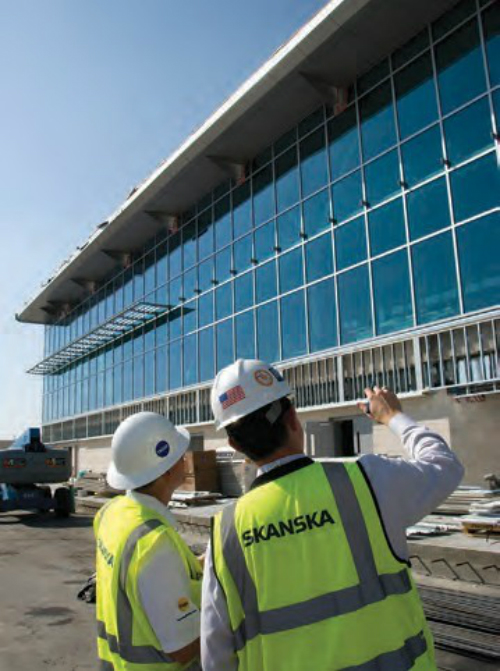Los Angeles is evolving. New rail connections provide people with dependable travel times from one part of the region to another. New buildings puncture the downtown skyline. New sports and entertainment venues take shape. Los Angeles International Airport is also changing in big ways.
The nation’s second busiest airport is, for many Angelinos, home base for travel, with the top five largest carriers in the United States all claiming LAX as a hub. Like most of our nation’s airports, LAX was built for a different era of air travel. I response, Los Angeles World Airports (LAWA) is undertaking a massive program to modernize LAX. The new international terminal is just the beginning. A new midfield satellite concourse is underway and, with the Metro Crenshaw light rail line in progress, LAX will connect passengers to transit for the first time via an automated people mover (APM) and a new consolidated rental car facility (CONRAC).
In six years, passengers will no longer need to run the traffic gauntlet of Century or Sepulveda Boulevards only to then contend with traffic on World Way, the LAX central terminal area loop road. That will soon be a thing of the past! Instead of a shuttle to your rental car, the APM will take you to one central building where all rental car companies and the Crenshaw Line will be located. Potentially, thousands of vehicles a day will be taken out of LAX circulation.
These are massive billion-dollar projects. Unlike other regional megaprojects, the fact that the APM and CONRAC will be built at a busy airport increases the number of logistical challenges to consider and address to ensure a successful project.
STAKEHOLDERS AT EVERY TURN
Consider what goes into making an airport work.
There are the airlines themselves, looking to make their operations as efficient as possible and eliminating delays, while at the same time providing a world class service to their customers. Behind those operations are baggage systems and handlers, ramp workers, gate agents and more. Obviously, there are the passengers themselves, hoping for an easy time navigating the airport for a seamless connection. There is the regulatory arm of the airport, from airport security to customs agents. Then there are the merchants marketing to this mass of people for retailing opportunities, from food to clothes to gifts and more.
We’re talking about thousands of people and millions of revenue dollars moving through an airport before mentioning cargo and shipping operations, hotels, rental car companies and more that rely on their proximity to the airport for their businesses. When you add in the surrounding community, there’s a large network of stakeholders with varied interests to keep abreast of many project facets.
To a construction and development firm, each one of these groups is a customer. Disrupting any of their operations can decrease their revenue streams as well as hinder the ability of the airport to operate normally.
CLOSE COLLABORATION IS THE KEY
To ensure success, contractors must work like an air traffic controller, seeing all the various pieces in motion and managing them for smooth operations. To do that, contractors must take an active role in project planning and stay in constant coordination with all stakeholders.
Late last year, Skanska finished a series of projects to enable construction of the new midfield satellite concourse at LAX. A variety of considerations kept the project moving smoothly for everyone. One part of the project required work around a major airline’s hangar and it was vital that our team worked with the airline to know where and when crews and materials could access the site without disruptions to their operations. For example, deliveries not prepared for airport security could have faced a delay, which would have set off a chain of events disrupting the airline and possibly the airport itself. Through constant communication, we avoided those issues.
Using alternative delivery methods such as progressive design-build (PDB) and construction management at risk (CMAR) that bring LAWA, airlines, vendors, community stakeholders, designers and contractors together at an early stage can improve overall planning for a project and allow for better logistics to identify aspects of a project that can potentially affect stakeholders. From there, proactive discussions with the stakeholders can occur, involving them in planning sessions to ensure minimal impact to their ongoing operations. Because LAWA uses alternative delivery procurement methods such as these, projects are more successful and every airport stakeholder benefits from the upfront communication.
Planning a project with stakeholders, including air travelers, in mind from the start yields the best results. Work can be phased in ways that do not disrupt operations and minimize inconvenience. Also, much like an airline sending passengers updates on gate assignments and schedule before a flight, the right planning keeps stakeholders informed from the start about what they can expect from construction and the efficiencies gained once the new facilities are in operation.
These are good strategies for any construction project. At an airport, though, with thousands of stakeholders with very different interests, the need for partnering, innovation, collaboration and timely communication is required for project success.
Dwight Pullen is a Senior Vice President at Skanska USA.

